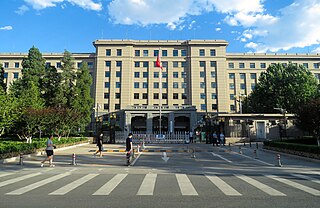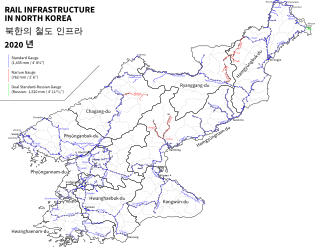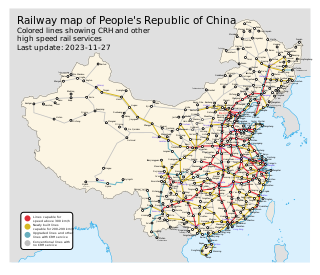
The transportation system in Mongolia consists of a network of railways, roads, waterways, and airports.

The Eurasian Land Bridge, sometimes called the New Silk Road, is the rail transport route for moving freight and passengers overland between Pacific seaports in the Russian Far East and China and seaports in Europe. The route, a transcontinental railroad and rail land bridge, currently comprises the Trans-Siberian Railway, which runs through Russia and is sometimes called the Northern East-West Corridor, and the New Eurasian Land Bridge or Second Eurasian Continental Bridge, running through China and Kazakhstan. As of November 2007, about one percent of the $600 billion in goods shipped from Asia to Europe each year were delivered by inland transport routes.

Choibalsan is the fourth-largest city in Mongolia after Ulaanbaatar, Darkhan, and Erdenet. The name of the city was Bayan Tümen until 1941, when it was renamed after the communist leader Khorloogiin Choibalsan in honor of the 20th anniversary of the Mongolian Revolution of 1921. It is the capital of the province of Dornod. The city administrative unit's official name is Kherlen sum, with area of 281 square kilometres or 108 square miles. It is situated at the Kherlen River, at an elevation of 747 metres or 2,451 feet above sea level.

Erdenet is the third-largest city in Mongolia, with a 2018 population of 98,057, and the capital of the aimag (province) of Orkhon. Located in the northern part of the country, it lies in a valley between the Selenge and Orkhon rivers about 240 km (149 mi) northwest of Ulaanbaatar, Darkhan, the capital. The road length between Ulaanbaatar and Erdenet is about 370 km (230 mi).

The Trans-Mongolian Railway links Ulan-Ude on the Trans-Siberian Railway in Buryatia, Russia, with Jining in Inner Mongolia, China, via Ulaanbaatar, the capital of Mongolia. It was completed in 1956 and runs from northwest to southeast, with major stations at Naushki/Sükhbaatar on the Russian border, Darkhan, Ulaanbaatar, Choir, Sainshand, and Zamyn-Üüd/Erenhot on the Chinese border. There are important branch lines to Erdenet and Baganuur.

The Islamic Republic of Iran Railways is the national state-owned railway system of Iran. The Raja Passenger Train Company is an associate of the IR, and manages its passenger trains. The Railway Transportation Company is an associate of the IR, which manages its freight transport. The Ministry of Roads & Urban Development is the state agency that oversees the IRIR. Some 33 million tonnes of goods and 29 million passengers are transported annually by the rail transportation network, accounting for 9 percent and 11 percent of all transportation in Iran, respectively (2011).

China State Railway Group Co., Ltd., doing business as China Railway (CR), is the national passenger and freight railroad corporation of the People's Republic of China.

Rail transport in Ukraine is a major mode of transport in Ukraine. Most railway infrastructure in Ukraine is owned by the government of Ukraine through Ukrzaliznytsia, a joint-stock company which has a de facto country-wide monopoly on passenger and freight transport by rail.

Afghanistan has three railway lines in the north of the country. The first is between Mazar-i-Sharif and the border town of Hairatan in Balkh province, which then connects with Uzbek Railways of Uzbekistan. The second links Torghundi in Herat province with Turkmen Railways of Turkmenistan. The third is between Turkmenistan and Aqina in Faryab province of Afghanistan, which extends south to the city of Andkhoy. The country currently lacks a passenger rail service, but a new rail link from Herat to Khaf in Iran for both cargo and passengers was recently completed. Passenger service is also proposed in Hairatan – Mazar-i-Sharif section and Mazar-i-Sharif – Aqina section.

Tavan Tolgoi is one of the world's largest untapped coking and thermal coal deposits, located in the Ömnögovi Province in southern Mongolia. It has a total estimated resource of 6.4 billion tonnes, one quarter of which is high quality coking coal. It is divided into six sections: Tsankhi, Ukhaa Khudag, Bor tolgoi, Borteeg, and Southwest and Eastern coalfields. The Tsankhi section is the largest part, and is divided into East and West Tsankhi - these have had the most focus recently.
Züünbayan, also Zuun-Bayan, Zun-Bayan, Dzun-Bayan is an urban-type settlement in Sainshand sum (district) of Dornogovi Province in South-Eastern Mongolia. This settlement is officially the 5th bag (commune) of the Dornogovi Province capital Sainshand, which sum territory was expanded for about 50 km south to the Gobi Desert to include Züünbayan. Züünbayan population was 1,917 and 1,606 at the end of 2008.

Rail transport in Myanmar consists of a 6,207.644 km (3,857 mi) railway network with 960 stations. The network, generally spanning north to south with branch lines to the east and west, is the second largest in Southeast Asia, and includes the Yangon Circular Railway which serves as a commuter railway for Yangon, the principal commercial city in Myanmar. The quality of the railway infrastructure is generally poor. The tracks are in poor condition, and are not passable during the monsoon season. The speed of freight trains is heavily restricted on all existing links as a consequence of poor track and bridge conditions. The maximum speed for freight trains has been quoted as 24 km/h (15 mph), suggesting that commercial speeds on this section could be as low as 12–14 km/h (7.5–8.7 mph).

Rail transport in Azerbaijan is operated by the national state-owned railway company Azerbaijan Railways. The railway network consists of 2,918 km (1,813 mi), its gauge is 1,520 mm, 815 km (506 mi) are double track and 1,272 km (790 mi) are electrified at 3 kV (3,000 V) DC.

Rail transport in North Korea is provided by Korean State Railway which is the only rail operator in North Korea. It has a network of over 6,000 km of track, of which the vast majority is standard gauge; there is, however, nearly 400 km of narrow gauge lines (762 mm) in various locations around the country.

Khanbumbat Airport, also Oyu Tolgoi Airport, is an airport in Khanbogd, Ömnögovi, Mongolia. The airport's construction was funded by the adjacent Oyu Tolgoi mine. It is the second airport in passenger traffic in Mongolia after Buyant-Ukhaa International Airport. The airport serves nearly 100,000 passengers annually.

Mining is important to the national economy of Mongolia. Mongolia is one of the 29 resource-rich developing countries identified by the International Monetary Fund and exploration of copper and coal deposits are generating substantial additional revenue.
Ceke Port of Entry is a port of entry on China's border with Mongolia. The only international border crossing within Alxa League of Inner Mongolia, Ceke is located in Ejin Banner, in the Gobi Desert. The locality on the opposite, (Outer) Mongolian, side of the border is called Shivee Khuren.

Rail transport is an important mode of long-distance transportation in China. As of 2024, the country had more than 159,000 km (98,798 mi) of railways, the second longest network in the world. By the end of 2023, China had more than 45,000 kilometres of high-speed rail (HSR), the longest HSR network in the world.

The China–Mongolia border is the international border between China and Mongolia. It runs from west to east between the two tripoints with Russia for 4,630 km (2,880 mi), with most of the boundary area lying in the Gobi Desert. It is the world's fourth longest international border.



















